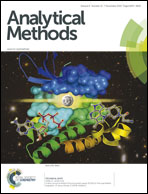A direct enzyme-linked immunosorbent assay (ELISA) for the quantitative evaluation of Janus Kinase 3 (JAK3) inhibitors
Abstract
The availability of a robust, precise and cost-efficient test system is the prerequisite for the performance of any medicinal chemistry program, especially in an academic environment. For the identification of novel Janus Kinase 3 inhibitors and determination of structure–activity relationships, a direct enzyme-linked immunosorbent assay was developed. Being applicable in a standard laboratory, the main advantage over existing methods is the basic equipment requirement as this assay does not need special handling originating from the use of cell cultures or radiometric readout. In contrast to earlier methods relying on two-step procedures, our assay uses a single peroxidase conjugated antibody to quantify and detect substrate phosphorylation. This optimized assay features a limit of detection of 0.032 μg mL−1, a wide dynamic range of 0.638 OD units and an appropriate Z′ factor of 0.66. The determined IC50 value for Tofacitinib was 3.5 ± 0.6 nM (n = 18). A detailed assay protocol custom-tailored for the JAK3 kinase domain and a step-by-step manual for optimizing specific assay conditions are presented. This ELISA primarily addresses researchers within the academic setting facing the task to identify lead structures and explore structure–activity relationships of JAK3 inhibitors at reasonable costs.


 Please wait while we load your content...
Please wait while we load your content...